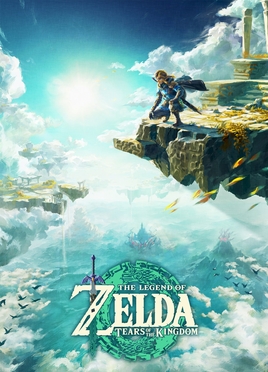Related Research Articles

The Legend of Zelda is an action-adventure game franchise created by the Japanese game designers Shigeru Miyamoto and Takashi Tezuka. It is primarily developed and published by Nintendo, although some portable installments and re-releases have been outsourced to Flagship, Vanpool, and Grezzo. The gameplay incorporates action-adventure and elements of action RPG games.

The Legend of Zelda is a video game franchise created by Japanese video game designers Shigeru Miyamoto and Takashi Tezuka. It is mainly developed and published by Nintendo. The universe of the Legend of Zelda series consists of a variety of lands, the most predominant being Hyrule. The franchise is set within a fantasy world that is reminiscent of medieval Europe and consists of several recurring locations, races and creatures. The most prominent population in the series are the Hylians, a humanoid race with elfin features, that are identifiable by their long, pointed ears. The game world is accompanied by a detailed fictional lore that contains a creation myth, several constructed languages, the most prominent being Hylian, and a fictional universal currency called the rupee. Most games in The Legend of Zelda series follow a similar storyline, which involves the protagonist Link battling monsters to save Princess Zelda and defeat an evil villain, which is often the series' main antagonist, Ganon. Nintendo developed the fictional lore into a complex timeline that spans across the series and chronicles thousands of years of fictional history.

The fourth wall is a performance convention in which an invisible, imaginary wall separates actors from the audience. While the audience can see through this "wall", the convention assumes the actors act as if they cannot. From the 16th century onward, the rise of illusionism in staging practices, which culminated in the realism and naturalism of the theatre of the 19th century, led to the development of the fourth wall concept.

Installation art is an artistic genre of three-dimensional works that are often site-specific and designed to transform the perception of a space. Generally, the term is applied to interior spaces, whereas exterior interventions are often called public art, land art or art intervention; however, the boundaries between these terms overlap.
Metafiction is a form of fiction that emphasizes its own narrative structure in a way that continually reminds the audience that they are reading or viewing a fictional work. Metafiction is self-conscious about language, literary form, and story-telling, and works of metafiction directly or indirectly draw attention to their status as artifacts. Metafiction is frequently used as a form of parody or a tool to undermine literary conventions and explore the relationship between literature and reality, life, and art.
Experience refers to conscious events in general, more specifically to perceptions, or to the practical knowledge and familiarity that is produced by these processes. Understood as a conscious event in the widest sense, experience involves a subject to which various items are presented. In this sense, seeing a yellow bird on a branch presents the subject with the objects "bird" and "branch", the relation between them and the property "yellow". Unreal items may be included as well, which happens when experiencing hallucinations or dreams. When understood in a more restricted sense, only sensory consciousness counts as experience. In this sense, experience is usually identified with perception and contrasted with other types of conscious events, like thinking or imagining. In a slightly different sense, experience refers not to the conscious events themselves but to the practical knowledge and familiarity they produce. In this sense, it is important that direct perceptual contact with the external world is the source of knowledge. So an experienced hiker is someone who actually lived through many hikes, not someone who merely read many books about hiking. This is associated both with recurrent past acquaintance and the abilities learned through them.

Link is a fictional character and the protagonist of Nintendo's video game franchise The Legend of Zelda. He was created by Japanese video game designer Shigeru Miyamoto. Link was introduced as the hero of the original 1986 The Legend of Zelda video game and has appeared in a total of 20 entries in the series, as well as a number of spin-offs. Common elements in the series include Link travelling through Hyrule whilst exploring dungeons, battling creatures and solving puzzles until he eventually defeats the series' primary antagonist, Ganon, and saves Princess Zelda.

Ganon is a fictional character and the primary antagonist of Nintendo's The Legend of Zelda video game series and franchise, as well as the final boss in many Zelda titles. In his humanoid Gerudo form, he is known as Ganondorf. A massive and malevolent porcine creature, Ganon first appeared in the original The Legend of Zelda game in 1986, while his alter ego, Ganondorf, was introduced in Ocarina of Time. He has since appeared in the majority of the games in the series in various forms. He is the archenemy of the protagonist Link and Princess Zelda of Hyrule and originally the leader of the Gerudo, a race of humanoid desert nomads before becoming the ruler of his demon army.
A bishōjo game or gal game is "a type of Japanese video game centered on interactions with attractive girls".
Meta-reference is a category of self-references occurring in many media or media artifacts like published texts/documents, films, paintings, TV series, comic strips, or video games. It includes all references to, or comments on, a specific medium, medial artifact, or the media in general. These references and comments originate from a logically higher level within any given artifact, and draw attention to—or invite reflection about—media-related issues of said artifact, specific other artifacts, or to parts, or the entirety, of the medial system. It is, therefore, the recipient's awareness of an artifact's medial quality that distinguishes meta-reference from more general forms of self-reference. Thus, meta-reference triggers media-awareness within the recipient, who, in turn "becomes conscious of both the medial status of the work" as well as "the fact that media-related phenomena are at issue, rather than (hetero-)references to the world outside the media." Although certain devices, such as mise-en-abîme, may be conducive to meta-reference, they are not necessarily meta-referential themselves. However, innately meta-referential devices constitute a category of meta-references.
Immersion journalism or immersionism is a style of journalism similar to gonzo journalism. In the style, journalists immerse themselves in a situation and with the people involved. The final product tends to focus on the experience, not the writer.

Immersion into virtual reality (VR) is a perception of being physically present in a non-physical world. The perception is created by surrounding the user of the VR system in images, sound or other stimuli that provide an engrossing total environment.

The term immersion marketing or immersive marketing includes traditional advertising, public relations, word-of-mouth advertising, digital marketing, samples, coupons, retail partnerships and other ways of surrounding the consumer with a consistent message about a brand. In essence, immersion marketing envelopes a brand or product or company issue so that the marketing, advertising, and public relations departments or representatives work holistically towards delivering the same brand message across multiple distribution channels. Unlike "Shotgun marketing"(communicate the message to anyone who listens), immersive marketing is cheaper and more effective, focusing directly on the customer's needs.

Immersive design describes design work which ranges in levels of interaction and leads users to be fully absorbed in an experience. This form of design involves the use of VR, AR, and MR that creates the illusion that the user is physically interacting with a realistic digital atmosphere.
The theory of sense data is a view in the philosophy of perception, popularly held in the early 20th century by philosophers such as Bertrand Russell, C. D. Broad, H. H. Price, A. J. Ayer, and G. E. Moore. Sense data are taken to be mind-dependent objects whose existence and properties are known directly to us in perception. These objects are unanalyzed experiences inside the mind, which appear to subsequent more advanced mental operations exactly as they are.
In video games, a silent protagonist is a player character who lacks any dialogue for the entire duration of a game, with the possible exception of occasional interjections or short phrases. In some games, especially visual novels, this may extend to protagonists who have dialogue, but no voice acting like all other non-player characters. A silent protagonist may be employed to lend a sense of mystery or uncertainty of identity to the gameplay, or to help the player identify better with them. Silent protagonists may also be anonymous. Not all silent protagonists are necessarily mute or do not speak to other characters; they may simply not produce any dialogue audible to the player.
Immersive Journalism is a form of journalism production that allows first person experience of the events or situations described in news reports and documentary film. Using 3D gaming and immersive technologies that create a sense of "being there" and offer the opportunity to personally engage with a story, immersive journalism puts an audience member directly into the event. By accessing a virtual version of the location where the story is occurring as a witness/participant, or by experiencing the perspective of a character depicted in the news story, the audience could be afforded unprecedented access to the sights and sounds, and even the feelings and emotions, which accompany the news.

The Legend of Zelda is a high-fantasy video game series created by Japanese game designers Shigeru Miyamoto and Takashi Tezuka. It is primarily developed and published by Nintendo, although some portable installments have been outsourced to Capcom, Vanpool and Grezzo. The series' gameplay incorporates elements of action, adventure and puzzle-solving games.
Immersive theater differentiates itself from traditional theater by removing the stage and immersing audiences within the performance itself. Often, this is accomplished by using a specific location (site-specific), allowing audiences to converse with the actors and interact with their surroundings (interactive), thereby breaking the fourth wall.

The Legend of Zelda: Tears of the Kingdom is a 2023 action-adventure game developed and published by Nintendo for the Nintendo Switch. The sequel to The Legend of Zelda: Breath of the Wild (2017), Tears of the Kingdom retains aspects including the open world of Hyrule, which has been expanded to allow for more vertical exploration. The player controls Link as he searches for Princess Zelda and fights to prevent the Demon King from destroying the world.
References
- ↑ "illusion | Definition of illusion in English by Oxford Dictionaries". Oxford Dictionaries | English. Archived from the original on 25 September 2016. Retrieved 20 January 2018.
- ↑ "aesthetic | Definition of aesthetic in English by Oxford Dictionaries". Oxford Dictionaries | English. Archived from the original on 25 September 2016. Retrieved 20 January 2018.
- 1 2 Nell, Victor (1988). Lost in a book : the psychology of reading for pleasure . New Haven: Yale University Press. ISBN 9780300041156. OCLC 15791755.
- 1 2 Ryan, Marie-Laure (1991). Possible worlds, artificial intelligence, and narrative theory. Bloomington: Indiana University Press. ISBN 9780253350046. OCLC 23219421.
- 1 2 Ryan, Marie-Laure (2015). Narrative as virtual reality 2: revisiting immersion and interactivity in literature and electronic media. Baltimore: Johns Hopkins University Press. ISBN 9781421417974. OCLC 905343871.
- ↑ Laura, Ermi; Frans, Mäyrä (2005). "Fundamental Components of the Gameplay Experience: Analysing Immersion" (PDF).
{{cite journal}}: Cite journal requires|journal=(help) - ↑ Thon, Jan-Noël (2008). "Immersion Revisited. On the Value of a Contested Concept" (PDF). In Leino, Olli; Wirman, Hanna; Fernandez, Amyris (eds.). Extending Experiences: Structure, Analysis and Design of Computer Game Player Experience. Lapland University Press. pp. 29–43. ISBN 9789524841979.
- 1 2 Wolf, Werner (2014). "Illusion (Aesthetic) | the living handbook of narratology". www.lhn.uni-hamburg.de. Archived from the original on 26 April 2018. Retrieved 20 January 2018.
{{cite web}}: CS1 maint: bot: original URL status unknown (link) - ↑ Gombrich, Ernst Hans (1960). Art and illusion: a study in the psychology of pictorial representation (Millennium ed., with a new preface by the author ed.). Princeton: Princeton University Press. ISBN 9780691070001. OCLC 45645369.
- ↑ "Prefaces and Prologues. Vol. 39. The Harvard Classics". www.bartleby.com. Retrieved 20 January 2018.
- ↑ McFarland, Thomas (1990). "Imagination and Illusion in English Romanticism". In Burwick, Frederick; Pape, Walter (eds.). Aesthetic Illusion: Theoretical and Historical Approaches. New York: de Gruyter. pp. 337–348. doi:10.1515/9783110884937.337. ISBN 9783110884937.
- ↑ Cairns, Paul; Cox, Anna; Nordin, A. Imran (2014). "Immersion in Digital Games: Review of Gaming Experience Research". In Angelides, Marios C.; Agius, Harry (eds.). Handbook of Digital Games. John Wiley & Sons, Inc. pp. 337–361. doi:10.1002/9781118796443.ch12. ISBN 9781118796443.
- ↑ Wolf, Werner (2013). "Aesthetic Illusion". In Wolf, Werner; Bernhart, Walter; Mahler, Andreas (eds.). Immersion and distance: aesthetic illusion in literature and other media. Amsterdam: Rodopi. pp. 1–63. ISBN 9789042036574. OCLC 855049877.
- ↑ Hardy, Thomas (2013) [1871]. Tess of the d'Urbervilles: A Pure Woman by Thomas Hardy. Urbana, Illinois: Project Gutenberg. Retrieved 20 January 2018.
- ↑ Welsh, Oli (2 March 2017). "The Legend of Zelda: Breath of the Wild review". Eurogamer. Retrieved 20 January 2018.
- ↑ Davis, Justin (21 March 2017). "100 Little Things in Zelda: Breath of the Wild That Will Blow Your Mind". IGN. Retrieved 20 January 2018.